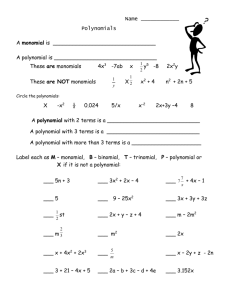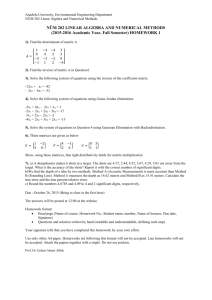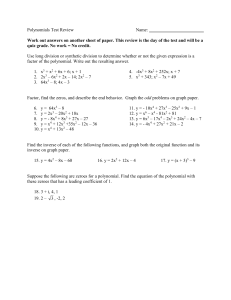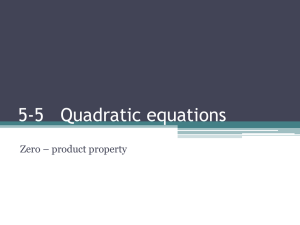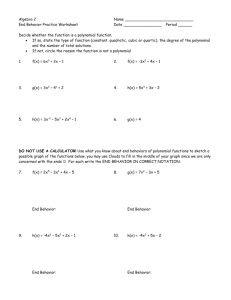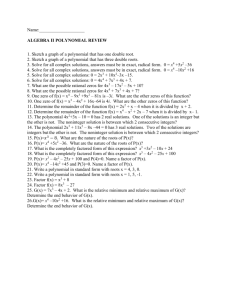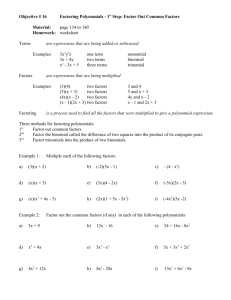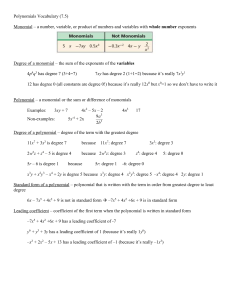Polynomial Notes
advertisement
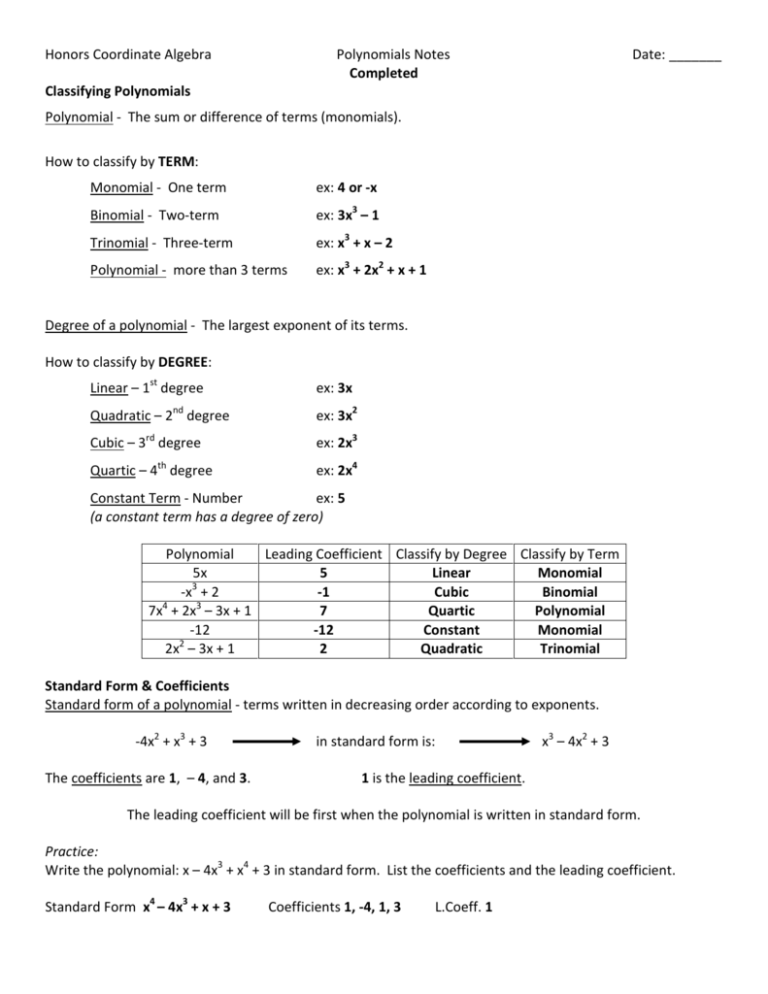
Honors Coordinate Algebra Polynomials Notes Completed Date: _______ Classifying Polynomials Polynomial - The sum or difference of terms (monomials). How to classify by TERM: Monomial - One term ex: 4 or -x Binomial - Two-term ex: 3x3 – 1 Trinomial - Three-term ex: x3 + x – 2 Polynomial - more than 3 terms ex: x3 + 2x2 + x + 1 Degree of a polynomial - The largest exponent of its terms. How to classify by DEGREE: Linear – 1st degree ex: 3x Quadratic – 2nd degree ex: 3x2 Cubic – 3rd degree ex: 2x3 Quartic – 4th degree ex: 2x4 Constant Term - Number ex: 5 (a constant term has a degree of zero) Polynomial Leading Coefficient Classify by Degree Classify by Term 5x 5 Linear Monomial -x3 + 2 -1 Cubic Binomial 4 3 7x + 2x – 3x + 1 7 Quartic Polynomial -12 -12 Constant Monomial 2 2x – 3x + 1 2 Quadratic Trinomial Standard Form & Coefficients Standard form of a polynomial - terms written in decreasing order according to exponents. -4x2 + x3 + 3 The coefficients are 1, – 4, and 3. in standard form is: x3 – 4x2 + 3 1 is the leading coefficient. The leading coefficient will be first when the polynomial is written in standard form. Practice: Write the polynomial: x – 4x3 + x4 + 3 in standard form. List the coefficients and the leading coefficient. Standard Form x4 – 4x3 + x + 3 Coefficients 1, -4, 1, 3 L.Coeff. 1 Rewrite the polynomials in standard form (if necessary). Identify the leading coefficient, and classify the polynomial by degree and by number of terms. Ex1) 4 – x + 2x2 Ex2) 2x + 4 – x3 St. Form 2x2 – x + 4 – x3 + 2x + 4 L. Coeff. 2 -1 By degree Quadratic Cubic By Terms Trinomial Trinomial Ex4) -x2 + 3x4 – 8 + 2x3 Ex3) -5 St. Form -5 3x4 + 2x3 – x2 – 8 L. Coeff. -5 3 By degree Constant Quartic By Terms Monomial Polynomial Combining Like Terms When combining like terms, add or subtract the coefficients, leaving the exponents the same. Make sure when writing out your answer that it is in standard form. Ex5) -4x3 + 7x – 8 + 2x3 – 11x – 4x3 + 2x3 + 7x – 11x – 8 –2x3 – 4x – 8 Ex7) 4x4 – 6x + 11x + x4 – 10 4x4 + x4 – 6x + 11x – 10 5x4 + 5x Ex6) 8x – 4x2 + 1 + 4x2 – 8x – 4x2 + 4x2 + 8x – 8x + 1 1 Ex8) -x + 7x2 + x – 2 7x2 – x + x – 2 7x2 – 2 Adding Polynomials without Grouping When adding polynomials combine like terms and write your answer in standard form. Ex9) (3x + 7x2 + 1) + (1 + 2x – 5x2) Ex10) (6x2 – 3x3 – 2x2) + (x3 + 2x2 + 1) -5x3 + 7x2 + 5x + 2 -2x3 + 6x2 + 1 Ex11) (6a + 6a4 + a3) + (3a3 – 5a4 – 6a) Ex12) (x4 + 2x3 + 3) + (8 – 2x3 + 2x4) a4 + 4a3 3x4 + 11 Note: If the coefficients combine to be zero, you do not write the variable (0 multiplied by a variable is 0) Distributing Practice Ex13) -(x + 4) ex14) -2(x + 3) -x – 4 -2x – 6 ex15) -(-x + 6) x–6 When subtracting polynomials it is important to remember to distribute the negative to all terms in the proceeding set of parenthesis. When working a subtraction problem, we will distribute the negative first and then combine like terms. Ex16) (2x3 + 3x – 4) – (5 – 6x + 3x3) Distribute the negative to the 2nd set of parenthesis (2x3 + 3x – 4) – (5 – 6x + 3x3) Switch the signs for all terms in the 2nd set of parenthesis (2x3 + 3x – 4) + (–5 + 6x – 3x3) Note: The problem becomes an addition problem –x3 + 9x – 9 Combine like terms for your answer Find the difference. Write the answer in standard form. Ex17) (4x2 – 3) – (2x2 + 6) (4x2 – 3) + (–2x2 – 6) 2x2 – 9 Ex19) (9x3 – 3x2 – 1) – (9x4 + 5x2 + 19) (9x3 – 3x2 – 1) + (–9x4 – 5x2 – 19) -9x4 + 9x3 – 8x2 – 20 Ex18) (-3x3 + 7) – (5x2 – x3) (-3x3 + 7) + (–5x2 + x3) -2x3 – 5x2 + 7 Ex20) (6x – 4x2 + 17x3) – (-8x3 + 5x2 – 11x) (6x – 4x2 + 17x3) + (8x3 – 5x2 + 11x) 25x3 – 9x2 + 17x
